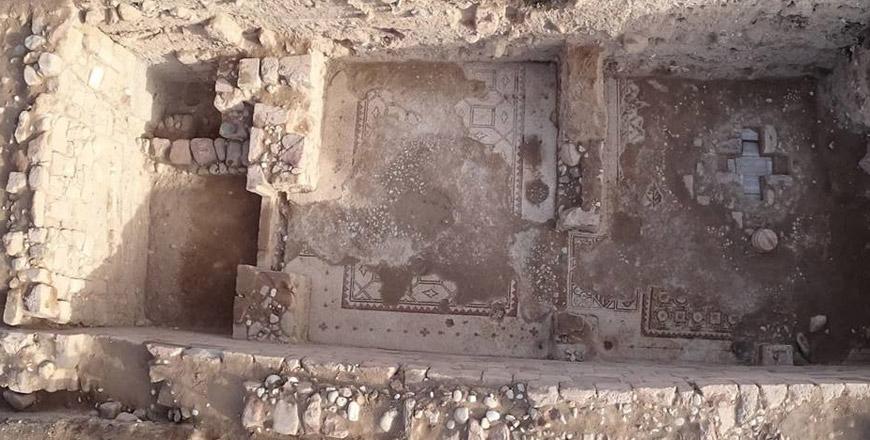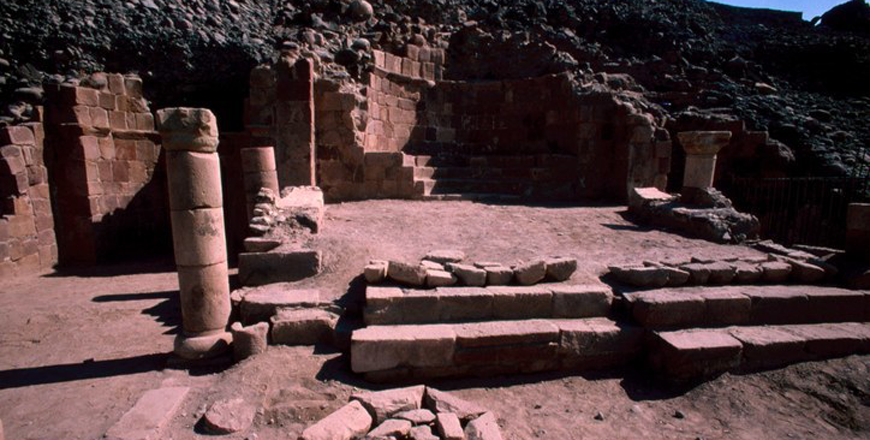You are here
Ancient Ghor Safi comes to light with the Zoara project
By Saeb Rawashdeh - Jul 03,2017 - Last updated at Jul 03,2017

The baptistry in Zoara Episcopal church (Photo courtesy of Konstantinos Politis)
AMMAN — Modern Ghor Safi, located at the southeastern end of the Dead Sea near the lowest point on earth, has been populated for over 12,000 years, as attested to by the “rich archaeological evidence” stretching from the Pre-Pottery Neolithic period to the Late Hellenistic/Nabataean, Roman, Byzantine, Islamic and Ottoman periods, a Greek scholar explained.
“It is accurately identified as ancient Zoora on the shore of the Dead Sea, next to the Sanctuary of Agios [saint] Lot, [where it is] depicted on the late-6th century mosaic floor map at Madaba,” Konstantinos Politis, an archaeologist and the chairperson of the Hellenic Society for Near Eastern Studies, said.
“Zoora, or Zoara, is represented as a walled town with three towers and an arched entrance gate surrounded by six date palms,” he said, noting that in the Old Testament Zoora is described as being one of the five ”cities of the plain” where Lot and his daughters initially fled after the destruction of Sodom and Gomorrah.
“Ghor Safi was a centre of a large Christian community and the seat of a bishop who attended the church councils in Nicaea [in modern-day Iznik, Turkey],” he continued.
The Ghor Safi archaeological project has located a significant number of sites since it began operating in 1997, the scholar noted, including the early Byzantine-medieval Islamic urban centre of Khirbet Al Sheikh Isa, the industrial complex of Masna Al Sukkar (commonly known as Tawahines Al Sukkar) and the Early Bronze Age and Byzantine cemeteries at Al Naq.
“Other parts include the sprawling Iron Age agricultural settlement of Tuleilat Qasr Mousa Hamid, the Nabataean fortress of Umm Tawabin with an associated dam below it, the early Christian hermitage at Wadi Al Hasa, and the ancient road along Wadi Sarmuj,” he stressed. “Further east, at the junction of wadis Hamarsh and Suweif, is a mega Pre-Pottery Neolithic B settlement.”
In the late 1990s, initial surveys and geophysical tests were carried out, followed by trial excavations in 2002 at the southwestern edges of Khirbet Al Sheikh Isa, which unearthed “the southern extent of the city walls and a number of internal rooms”.
“At the western and eastern perimeters there was good evidence for churches,” Politis stated, adding that a “wider survey of the vicinity and surrounding slopes identified the limits and discerned the ancient agricultural field system.”
In 2004, researchers expanded their work and found the eastern pressing chamber at Masna Al Sukkar (the sugar factory complex) and at Khirbet Al Sheikh Isa (the city centre), the archaeologist noted.
The city centre was not only significant because it marked the main marketplace, but also due to its “substantial” stratified deposits rich in material and environmental finds, Politis emphasised.
“New excavations were made in the Byzantine part of the cemetery at Al Naq, where over 400 hundred important, 4th-6th century Greek and Aramaic-inscribed tombstones have been recovered in recent years,” he said.
Unfortunately, the cemetery has been badly looted by tomb robbers and it had never been officially excavated before, so these excavations have been essential in identifying the origin of these tombstones, the expert added.
In order to identify the extent of the two settlement sites of Khirbet Al Sheikh Isaand Tuleilat Qasr Mousa Hamid, surveying has been carried out around them, he added.
“The former mediaeval Islamic city is much more extensive than the current, officially claimed antiquities property, and it is obvious that additional lands need to be acquired,” Politis pointed out, adding that “the latter site also proved to be a more extensive Iron Age II agriculturally based [primarily wheat and barley] settlement, with evidence of Roman occupation in the upper levels”.
In 2008 and 2009, fieldwork seasons in Ghor Safi concentrated on the Byzantine paved street and a mosaic floor was revealed, he said, noting that most of the finds included pottery from the Abbasid and Ayyubid/Mamluk periods, which were linked to the sugar and indigo production that was well-known from mediaeval historical sources, Politis underlined.
However, the archaeological team recently unearthed an extensive basilica complex in the city centre with a rare cruciform-shaped baptistery in Jordan, the archaeologist highlighted.
Inscriptions on tomb stones indicated the presence of local Semitic and Nabataean communities and the adult baptistery shows that systematic Christian conversions took place during early Byzantine times, the scholar said.
It will take a few years of studying the finds before final conclusions are reached about the church’s historical role, Politis said, adding that the first reports will be published in a book by the Palestine Exploration Fund in London next year.
This was announced in a public lecture at the British Museum on
June 9.
A USAID grant in 2015 initiated the conservation, protection and visitors’ enhancement of the Ghor Safi sites in collaboration with the Hellenic Society for Near Eastern Studies, the scholar explained, adding that these works is continued during 2017 with the Al Hima Foundation supported by Zain Communications, Al Hikma and The King Abdullah II Development Fund.
From the beginning of 2018, a grant will help consolidate structures and create a shelter over parts of the sugar factory complex, Politis said.
However, the whole region is still threatened by constant agricultural and urban development which negatively affects ancient sites, Politis warned, underlining that “archaeologists must always be vigilant”.
Related Articles
AMMAN — Last week’s international colloquium on the Byzantine and Islamic periods in Ghor Safi featured Australian numismatics specialist Pe
AMMAN — The Dead Sea region has been inhabited since prehistoric times, with thousands of graves dating back to the Neolithic and Bronze Age
AMMAN — Greek archaeologist Konstantinos Politis is a familiar face among many local and foreign researchers in the Kingdom; he has been exc













